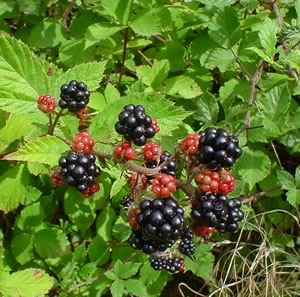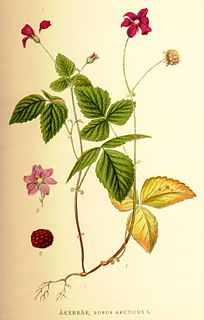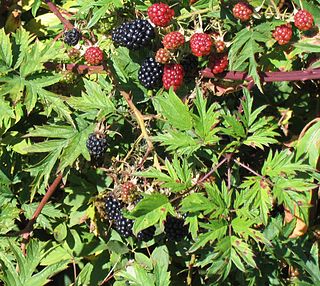
Rubus is a large and diverse genus of flowering plants in the rose family, Rosaceae, subfamily Rosoideae, with 250–700 species.

The blackberry is an edible fruit produced by many species in the genus Rubus in the family Rosaceae, hybrids among these species within the subgenus Rubus, and hybrids between the subgenera Rubus and Idaeobatus. The taxonomy of the blackberries has historically been confused because of hybridization and apomixis, so that species have often been grouped together and called species aggregates. For example, the entire subgenus Rubus has been called the Rubus fruticosus aggregate, although the species R. fruticosus is considered a synonym of R. plicatus.

The raspberry is the edible fruit of a multitude of plant species in the genus Rubus of the rose family, most of which are in the subgenus Idaeobatus. The name also applies to these plants themselves. Raspberries are perennial with woody stems.

Rubus spectabilis, the salmonberry, is a species of brambles in the rose family, native to the west coast of North America from west central Alaska to California, inland as far as Idaho.

Rubus occidentalis is a species of Rubus native to eastern North America. Its common name black raspberry is shared with the closely related western American species Rubus leucodermis. Other names occasionally used include wild black raspberry, bear's eye blackberry, black caps, black cap raspberry, and scotch cap.

Rubus parviflorus, commonly called thimbleberry, is a species of Rubus native to northern temperate regions of North America. It bears edible red fruit similar in appearance to a raspberry, but shorter, almost hemispherical. Because the fruit does not hold together well, it has not been commercially developed for the retail berry market, but is cultivated for landscapes. The plant has large hairy leaves and no thorns.

Rubus arcticus, the Arctic bramble or Arctic raspberry, is a species of slow-growing bramble belonging to the rose family, found in arctic and alpine regions in the Northern Hemisphere.

Rubus leucodermis, also called whitebark raspberry, blackcap raspberry or blue raspberry, is a species of Rubus native to western North America, from Alaska south as far as California, Arizona, New Mexico, and Chihuahua.

Rubus laciniatus, the cutleaf evergreen blackberry or evergreen blackberry, is a species of Rubus, native to Eurasia. It is an introduced species in Australia and North America. It has become a weed and invasive species in forested habitats in the United States and Canada, particularly in the Northeast and along the Pacific Coast.

Rubus armeniacus, the Himalayan blackberry or Armenian blackberry, is a species of Rubus in the blackberry group Rubus subgenus Rubus series Discolores Focke. It is native to Armenia and Northern Iran, and widely naturalised elsewhere. Both its scientific name and origin have been the subject of much confusion, with much of the literature referring to it as either Rubus procerus or Rubus discolor, and often mistakenly citing its origin as western European. Flora of North America, published in 2014, considers the taxonomy unsettled, and tentatively uses the older name Rubus bifrons.

Rubus ursinus is a North American species of blackberry or dewberry, known by the common names California blackberry, California dewberry, Douglas berry, Pacific blackberry, Pacific dewberry and trailing blackberry.

Glyptopleura is a genus of North American plants in the dandelion family. The common names for this plant include carveseed, holy dandelion, keysia, and crustleaf.

Rubus pubescens is a herbaceous perennial widespread across much of Canada and the northern United States, from Alaska to Newfoundland, south as far as Oregon, Colorado, and West Virginia.
Polygonum heterosepalum, common name dwarf desert knotweed or oddsepal knotweed, is a plant species native to the Great Basin Desert in southwestern Idaho, northern Nevada, northeastern California, and southwestern Oregon. It has been reported from 1 county in California (Modoc), 4 in Nevada, 4 in Idaho, and 5 in Oregon. The species occurs in dry, open sites in sagebrush plains and pine woodlands.

Allium crenulatum, common name Olympic onion, is a plant species native to Oregon, Washington, and British Columbia. It grows in the Cascades, the Coast Ranges, the Olympic Mountains, the Wenatchee Mountains, and the mountains on Vancouver Island. There is one report from Alabama, but this needs verification. The species grows on talus slopes and in alpine tundra at elevations of 600–2500 m.
Morton Eaton Peck (1871-1959) was an American botanist specializing in flora of Oregon. He was professor of botany at Willamette University. He wrote Manual of the Higher Plants of Oregon. Botanist Arthur Cronquist commented that Peck's Oregon plant collection was "the most complete, so far as I know that exists."
Manual of the Higher Plants of Oregon was an early flora of plants of Oregon written by Morton Peck.

Rubus vestitus is a European species of brambles in the rose family, called European blackberry in the United States. It is native to Europe and naturalized along the northern Pacific Coast of the United States and Canada.

Rubus cuneifolius, the sand blackberry, is a North American species of flowering plant in the rose family. It occurs in the eastern United States in every coastal state from Louisiana to New Hampshire, with the exception of Rhode Island. There are also reports of inland populations in Tennessee, Arkansas, and Oklahoma, and the species has become naturalized in South Africa.
Rubus setosus, the bristly blackberry, is a North American species of flowering plant in the rose family. It is widespread in much of central and eastern Canada and the northeastern and north-central United States















